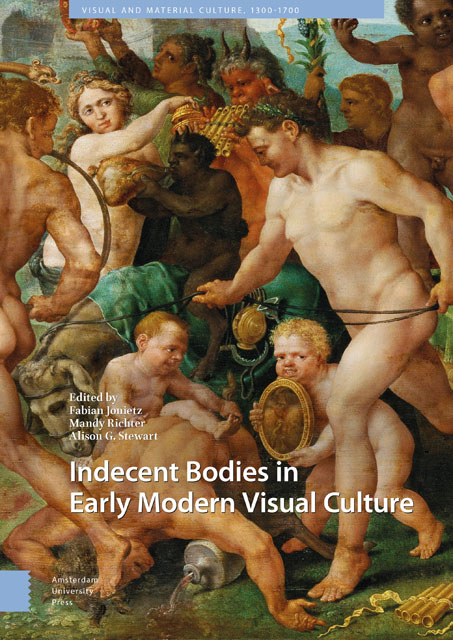Book contents
- Frontmatter
- Table of Contents
- List of Illustrations
- Indecent Bodies in Early Modern Visual Culture: An Introduction
- 1 Taste, Lust, and the Male Body: Sexual Representations in Early Sixteenth-Century Northern Europe
- 2 Private Viewings: The Frankfurt Context of Sebald Beham’s Die Nacht
- 3 To Show or Not to Show? Marcantonio Raimondi and the Representation of Female Pubic Hair
- 4 Treating Bodily Impurities: Skin, Art, and Medicine
- 5 Indecent Exposure and Honourable Uncovering in Renaissance Portraits of Women
- 6 Lust in Translation: Agency, Sexuality, and Gender Configuration in Pauwels Franck’s Allegories of Love
- 7 ‘So this guy walks into a forest…:’ obscenity, humour, sex, and the equine body in hans baldung’s Horses in a forest woodcuts (1534)
- 8 Indecent Creativity and the Tropes of Human Excreta
- 9 ‘It All Turns to Shit’ – The Land of Cockaigne in Sixteenth-Century German Woodcuts
- 10 Noëls and Bodily Fluids: The Business of Low-Country Ceremonial Fountains
- Index
4 - Treating Bodily Impurities: Skin, Art, and Medicine
Published online by Cambridge University Press: 19 April 2023
- Frontmatter
- Table of Contents
- List of Illustrations
- Indecent Bodies in Early Modern Visual Culture: An Introduction
- 1 Taste, Lust, and the Male Body: Sexual Representations in Early Sixteenth-Century Northern Europe
- 2 Private Viewings: The Frankfurt Context of Sebald Beham’s Die Nacht
- 3 To Show or Not to Show? Marcantonio Raimondi and the Representation of Female Pubic Hair
- 4 Treating Bodily Impurities: Skin, Art, and Medicine
- 5 Indecent Exposure and Honourable Uncovering in Renaissance Portraits of Women
- 6 Lust in Translation: Agency, Sexuality, and Gender Configuration in Pauwels Franck’s Allegories of Love
- 7 ‘So this guy walks into a forest…:’ obscenity, humour, sex, and the equine body in hans baldung’s Horses in a forest woodcuts (1534)
- 8 Indecent Creativity and the Tropes of Human Excreta
- 9 ‘It All Turns to Shit’ – The Land of Cockaigne in Sixteenth-Century German Woodcuts
- 10 Noëls and Bodily Fluids: The Business of Low-Country Ceremonial Fountains
- Index
Summary
Abstract
Early modern physicians, theorists, and artists shared a knowledge of thehuman body that merged aesthetics with empirical knowledge about therealities of the physical constitution. For instance, books of secrets,such as Giovanni Marinello's ‘Women'sEmbellishments’ (Gli ornamenti delle donne,1562), discussed at great length ‘infirmities’ of theskin, including stains, odours and bodily fluids that unsettlednormative beauty standards. This essay considers examples of suchambivalent discourses in medical writings (Mercurialis) and books ofsecrets (Marinello, Della Porta) written in humanistic settings withregard to treatments of the body such as cosmetics practices in thecontext of Early Modern dietetics.
Keywords: art theory; books of secrets; complexion;cosmetics; dermatology; skin
Early modern physicians, theorists, and artists shared a knowledge of thehuman body that merged aesthetics with empirical knowledge about therealities of the physical constitution. For instance, books of secrets, suchas Giovanni Marinello's ‘Women's Embellishments’(Gli ornamenti delle donne, 1562), discussed at greatlength male and female indecencies and ‘infermities’ of theskin (infermita del corpo di fuori), including stains,odours and bodily fluids, that unsettled the book's normative beautystandards. This essay considers examples of such ambivalent discourses inmedical writings and books of secrets written in professional humanisticsettings with regard to treatments of the body such as cosmetics practicesin the context of Early Modern dietetics.
In the Early Modern period, the term ‘complexion’ meant morethan just the colouration, texture, and appearance of human skin. Instead,deriving from the Latin word complexio(‘complex’, ‘connection’, gr.κρáσις,transl. krásis, ‘mixture’,‘compound’), it referred to the combination of the humours,the four body fluids – black bile, yellow bile, phlegm and blood– that were thought to influence the human constitution, temperamentand health according to the ancient tradition of humouralism.
Accordingly, the modern conception of the human skin as the outer border ofthe body as well as its largest organ was unknown in the premodern area.Instead, the skin (Latin cutis or pellis)was considered a porous membrane without function, permeable to both theinside of the body and its environments. Likewise, the ideal of a flawless,intact unity of the dermis was unfamiliar. Rather, bathers cut and bled itby means of purification techniques such as bloodletting and cupping.
- Type
- Chapter
- Information
- Indecent Bodies in Early Modern Visual Culture , pp. 109 - 128Publisher: Amsterdam University PressPrint publication year: 2022



